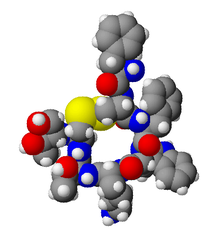- Octreotide
-
Octreotide 

Systematic (IUPAC) name (4R,7S,10S,13R,16S,19R)-10-(4-aminobutyl)-19-
[[(2R)-2-amino-3-phenyl-propanoyl]amino]-16-
benzyl-N-[(2R,3R)-1,3-dihydroxybutan-2-yl]-7-
(1-hydroxyethyl)-13-(1H-indol-3-ylmethyl)-6,9,12,
15,18-pentaoxo-1,2-dithia-5,8,11,14,17-
pentazacycloicosane-4-carboxamideClinical data Trade names Sandostatin AHFS/Drugs.com monograph Pregnancy cat. B(US) Legal status ℞ Prescription only Routes Subcutaneous, intramuscular, intravenous Pharmacokinetic data Bioavailability 100%; I.M.: 60% to 63% of subcutaneous dose Protein binding 65% Metabolism Hepatic Half-life 1.7–1.9 hours Identifiers CAS number 83150-76-9 
79517-01-4 (acetate)
135467-16-2 (pamoate)ATC code H01CB02 PubChem CID 54373 DrugBank BTD00088 ChemSpider 10482007 
UNII RWM8CCW8GP 
KEGG D00442 
ChEMBL CHEMBL1680 
Chemical data Formula C49H66N10O10S2 Mol. mass 1019.24 g/mol SMILES eMolecules & PubChem - InChI=1S/C49H66N10O10S2/c1-28(61)39(25-60)56-48(68)41-27-71-70-26-40(57-43(63)34(51)21-30-13-5-3-6-14-30)47(67)54-37(22-31-15-7-4-8-16-31)45(65)55-38(23-32-24-52-35-18-10-9-17-33(32)35)46(66)53-36(19-11-12-20-50)44(64)59-42(29(2)62)49(69)58-41/h3-10,13-18,24,28-29,34,36-42,52,60-62H,11-12,19-23,25-27,50-51H2,1-2H3,(H,53,66)(H,54,67)(H,55,65)(H,56,68)(H,57,63)(H,58,69)(H,59,64)/t28-,29?,34-,36+,37+,38-,39-,40+,41+,42+/m1/s1

Key:DEQANNDTNATYII-RRCPSWKPSA-N
 (what is this?) (verify)
(what is this?) (verify)Octreotide (brand name Sandostatin, Novartis Pharmaceuticals) is an octapeptide that mimics natural somatostatin pharmacologically, though it is a more potent inhibitor of growth hormone, glucagon, and insulin than the natural hormone. It was first synthesized in 1979 by the chemist Wilfried Bauer.
Contents
Uses
Approved uses
The Food and Drug Administration (FDA) has approved the usage of a salt form of this peptide, octreotide acetate, as an injectable depot formulation for the treatment of acromegaly, diarrhea and flushing episodes associated with carcinoid syndrome, and diarrhea in patients with vasoactive intestinal peptide-secreting tumors (VIPomas).
Radiolabelling
Further information: Octreotide scanOctreotide is used in nuclear medicine imaging by labelling with indium-111 (Octreoscan) to noninvasively image neuroendocrine and other tumours expressing somatostatin receptors.[1] More recently, it has been radiolabelled with gallium-68, enabling imaging with positron emission tomography (PET), which provides higher resolution and sensitivity.
Octreotide can also be labelled with a variety of radionuclides, such as yttrium-90 or lutetium-177, to enable peptide receptor radionuclide therapy (PRRT) for the treatment of unresectable neuroendocrine tumours.
Off-label and experimental uses
Octreotide has also been used off-label for the treatment of severe, refractory diarrhea from other causes. It is used in toxicology for the treatment of prolonged recurrent hypoglycemia after sulfonylurea and possibly meglitinides overdose. It has also been used with varying degrees of success in infants with nesidioblastosis to help decrease insulin hypersecretion.
In patients with suspected esophageal varices, octreotide can be given to help decrease bleeding.[2] It has been investigated for patients with pain from chronic pancreatitis,[3] and it may be useful in the treatment of thymic neoplasms.[citation needed]
The drug has been used off-label, injected subcutaneously, in the management of hypertrophic pulmonary osteoarthropathy (HPOA) secondary to non-small cell lung carcinoma. Although its mechanism is not known, it appears to reduce the pain associated with HPOA.[citation needed]
It has been used in the treatment of malignant bowel obstruction.[4]
Octreotide may be used in conjunction with midodrine to partially reverse peripheral vasodilation in the hepatorenal syndrome. By increasing systemic vascular resistance, these drugs reduce shunting and improve renal perfusion, prolonging survival until definitive treatment with liver transplant.[5]
While successful treatment has been demonstrated in case reports[6][7], larger studies have failed to demonstrate efficacy in treating chylothorax.[8]
A small study has shown that octreotide may be effective in the treatment of idiopathic intracranial hypertension.[9][10]
Contraindications
Octreotide has not been adequately studied for the treatment of children, pregnant and lactating women. The drug is given to these groups of patients only if a risk-benefit analysis is positive.[11][12]
Adverse effects
The most frequent adverse effects (more than 10% of patients) are headache, hypothyroidism, cardiac conduction changes, gastrointestinal reactions (including cramps, nausea/vomiting and diarrhea or constipation), gallstones, reduction of insulin release, hyperglycemia[13] or hypoglycemia, and (usually transient) injection site reactions. Slow heart rate, skin reactions such as pruritus, hyperbilirubinemia, hypothyreosis, dizziness and dyspnea are also fairly common (more than 1%). Rare side effects include acute anaphylactic reactions, pancreatitis and hepatitis.[11][12]
Some studies reported alopecia in patients who were treated by octreotide.[14] Rats which were treated by octreotide experienced erectile disfunction in a 1998 study.[15] A prolonged QT interval has been observed in patients, but it is uncertain whether this is a reaction to the drug or part of the patients' illnesses.[11]
Pharmacokinetics
Octreotide is absorbed quickly and completely after subcutaneous application. Maximal plasma concentration is reached after 30 minutes. The elimination half-life is 100 minutes (1.7 hours) on average when applied subcutaneously; after intravenous injection, the substance is eliminated in two phases with half-lives of 10 and 90 minutes, respectively.[11][12]
Pharmacological effects
Since octreotide resembles somatostatin in physiological activities, it can:
- inhibit secretion of many hormones, such as gastrin, cholecystokinin, glucagon, growth hormone, insulin, secretin, pancreatic polypeptide, TSH, and vasoactive intestinal peptide,
- reduce secretion of fluids by the intestine and pancreas,
- reduce gastrointestinal motility and inhibit contraction of the gallbladder,
- inhibit the action of certain hormones from the anterior pituitary,
- cause vasoconstriction in the blood vessels, and
- reduce portal vessel pressures in bleeding varices.
It has also been shown to produce analgesic effects, most probably acting as a partial agonist at the mu opioid receptor.[16][17]
Interactions
Octreotide can reduce the intestinal resorption of ciclosporin, possibly making it necessary to increase the dose.[18] Patients with diabetes mellitus might need less insulin or oral antidiabetics when treated with octreotide. The bioavailability of bromocriptine is increased;[12] besides being an antiparkinsonian, bromocriptine is also used for the treatment of acromegaly.
See also
- Octreotate, a closely related peptide
References
- ^ Medscape: Octreoscan review
- ^ Abid S, Jafri W, Hamid S, et al. (March 2009). "Terlipressin vs. octreotide in bleeding esophageal varices as an adjuvant therapy with endoscopic band ligation: a randomized double-blind placebo-controlled trial". Am. J. Gastroenterol. 104 (3): 617–23. doi:10.1038/ajg.2008.147. PMID 19223890.
- ^ Uhl W, Anghelacopoulos SE, Friess H, Büchler MW (1999). "The role of octreotide and somatostatin in acute and chronic pancreatitis". Digestion 60 Suppl 2: 23–31. doi:10.1159/000051477. PMID 10207228.
- ^ Shima Y, Ohtsu A, Shirao K, Sasaki Y (May 2008). "Clinical efficacy and safety of octreotide (SMS201-995) in terminally ill Japanese cancer patients with malignant bowel obstruction". Japanese journal of clinical oncology 38 (5): 354–9. doi:10.1093/jjco/hyn035. PMID 18490369. http://jjco.oxfordjournals.org/cgi/pmidlookup?view=long&pmid=18490369.
- ^ Skagen C, Einstein M, Lucey MR, Said A (Feb 2009). "Combination Treatment With Octreotide, Midodrine, and Albumin Improves Survival in Patients With Type 1 and Type 2 Hepatorenal Syndrome.". J Clin Gastroenterol. 43 (7): 680–5. doi:10.1097/MCG.0b013e318188947c. PMID 19238094.
- ^ Dalokay Kilic, MD, Ekber Sahin, MD, Oner Gulcan, MD, Bulent Bolat, MD, Riza Turkoz, MD, Ahmet Hatipoglu, MD (2005). "Octreotide for Treating Chylothorax after Cardiac Surgery". Texas Heart Institute Journal 32 (3): 437–39. PMC 1336729. PMID 16392238. http://www.pubmedcentral.nih.gov/articlerender.fcgi?tool=pmcentrez&artid=1336729.
- ^ Marcia L. Buck, Pharm.D., FCCP (2004). "Octreotide for the Management of Chylothorax in Infants and Children". Pediatric Pharmacotherapy 10 (10). http://www.medscape.com/viewarticle/494653.
- ^ Chan, Emily, Russell, Jennifer MD, Williams, William MD, Van Arsdell, Glen MD, Coles, John MD, McCrindle, Brian MD (2005). "Postoperative Chylothorax After Cardiothoracic Surgery in Children". Annals of Thoracic Surgery 80 (11): 1864-71. PMID 16242470.
- ^ Greek Researchers Investigate Octreotide Hypertension Research Foundation, accessed 2011-01-02
- ^ G. N. Panagopoulos, S. N. Deftereos, G. A. Tagaris, M. Gryllia, T. Kounadi, O. Karamani, D. Panagiotidis, E. Koutiola-Pappa, C. E. Karageorgiou, G. Piadites (2007-07-10). "Octreotide: A therapeutic option for idiopathic intracranial hypertension". Neurology, Neurophysiology and Neuroscience. http://www.neurojournal.com/article/view/1120. Retrieved 2011-01-02.
- ^ a b c d Haberfeld, H, ed (2009) (in German). Austria-Codex (2009/2010 ed.). Vienna: Österreichischer Apothekerverlag. ISBN 3-85200-196-X.
- ^ a b c d Dinnendahl, V, Fricke, U, ed (2010) (in German). Arzneistoff-Profile. 8 (23 ed.). Eschborn, Germany: Govi Pharmazeutischer Verlag. ISBN 978-3-7741-98-46-3.
- ^ Hovind, P; Simonsen, L; Bülow, J (2010). "Decreased leg glucose uptake during exercise contributes to the hyperglycaemic effect of octreotide.". Clinical physiology and functional imaging 30 (2): 141–5. doi:10.1111/j.1475-097X.2009.00917.x. PMID 20132129.
- ^ Van Der Lely, AJ; De Herder, WW; Lamberts, SW (1997). "A risk-benefit assessment of octreotide in the treatment of acromegaly". Drug safety : an international journal of medical toxicology and drug experience 17 (5): 317–24. PMID 9391775.
- ^ Kapicioglu, S; Mollamehmetoglu, M; Kutlu, N; Can, G; Ozgur, GK (1998). "Inhibition of penile erection in rats by a long-acting somatostatin analogue, octreotide (SMS 201-995)". British journal of urology 81 (1): 142–5. PMID 9467491.
- ^ Maurer R, Gaehwiler BH, Buescher HH, Hill RC, Roemer D. Opiate antagonistic properties of an octapeptide somatostatin analog. Proceedings of the National Academy of Sciences USA. 1982 Aug;79(15):4815-7. PMID 6126877
- ^ Allen MP, Blake JF, Bryce DK, Haggan ME, Liras S, McLean S, Segelstein BE. Design, synthesis and biological evaluation of 3-amino-3-phenylpropionamide derivatives as novel mu opioid receptor ligands. Bioorganic and Medicinal Chemistry Letters. 2000 Mar 20;10(6):523-6. PMID 10741545
- ^ Klopp, T, ed (2010) (in German). Arzneimittel-Interaktionen (2010/2011 ed.). Arbeitsgemeinschaft für Pharmazeutische Information. ISBN 978-3-85200-207-1.
Hypothalamic-pituitary hormones and analogues (H01) Hypothalamic Agonists: Lanreotide • OctreotideAnterior pituitary Agonists: Corticotropin • Cosyntropin • TetracosactideAgonists: ThyrotropinPosterior pituitary Agonists: Argipressin • Desmopressin • Felypressin • Lypressin • Ornipressin • Terlipressin
Antagonists: Conivaptan • Demeclocycline • Lixivaptan • Mozavaptan • Nelivaptan • Relcovaptan • Satavaptan • TolvaptanCategories:- Hormonal agents
- Peptides
- InChI=1S/C49H66N10O10S2/c1-28(61)39(25-60)56-48(68)41-27-71-70-26-40(57-43(63)34(51)21-30-13-5-3-6-14-30)47(67)54-37(22-31-15-7-4-8-16-31)45(65)55-38(23-32-24-52-35-18-10-9-17-33(32)35)46(66)53-36(19-11-12-20-50)44(64)59-42(29(2)62)49(69)58-41/h3-10,13-18,24,28-29,34,36-42,52,60-62H,11-12,19-23,25-27,50-51H2,1-2H3,(H,53,66)(H,54,67)(H,55,65)(H,56,68)(H,57,63)(H,58,69)(H,59,64)/t28-,29?,34-,36+,37+,38-,39-,40+,41+,42+/m1/s1
Wikimedia Foundation. 2010.
